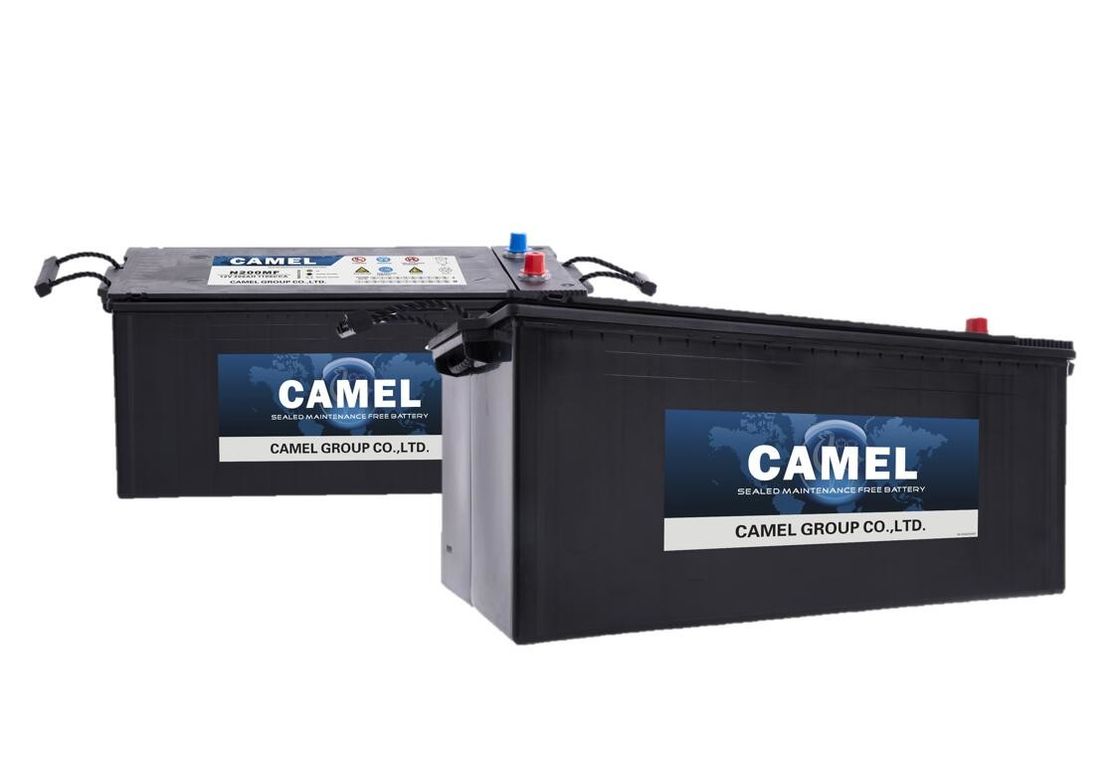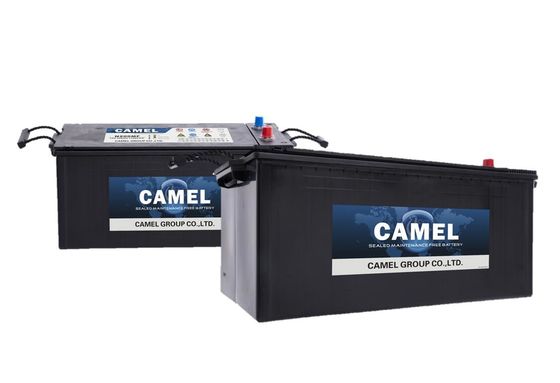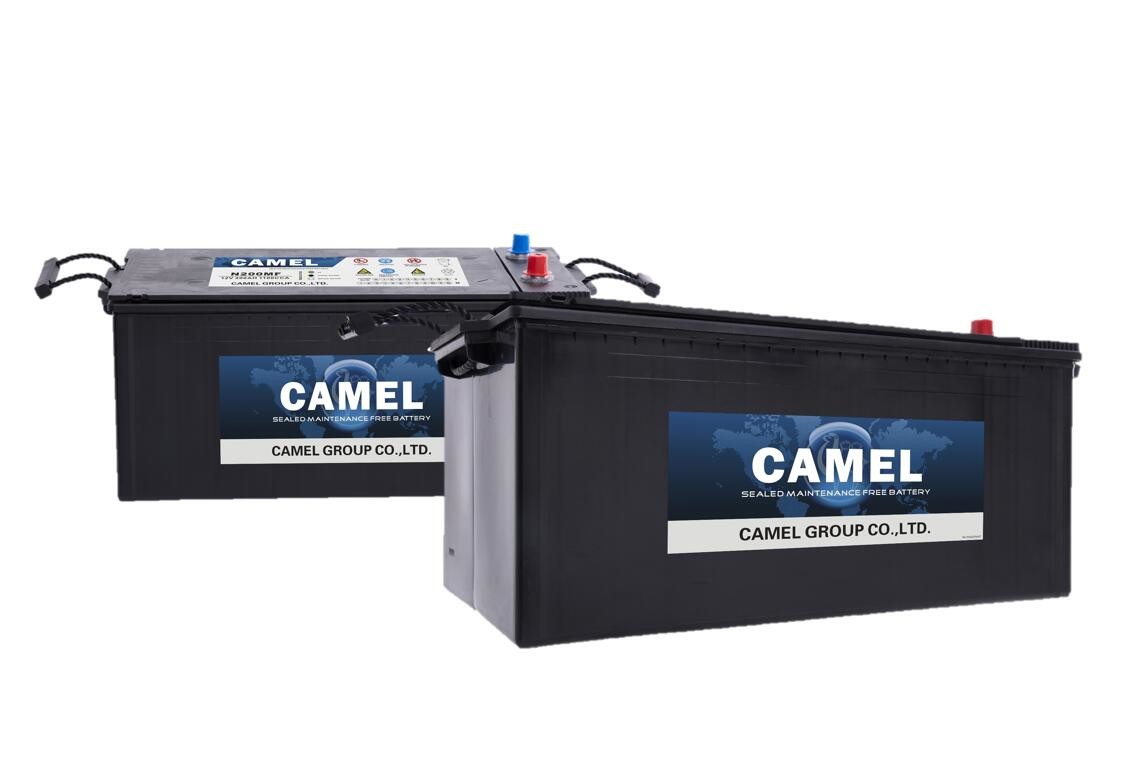AS Standard G31 Lead-acid 12V Heavy Truck Cranking Battery
A battery is an electrochemical device for converting chemical energy into electrical energy. That electrical energy cranks the engine over for starting and powers the ignition system. The battery also acts as a voltage stabilizer for the electrical system. It provides current for limited periods when a vehicle’s electrical demands exceed the charging system’s capacity, or the charging system isn’t operating correctly. Therefore, the heavy duty truck needs larger battery. The physically larger batteries generate greater amperage. And, as trucks generally have larger engines than cars they require more amps to turn the engine for starting because there’s more inertia, internal friction, compression, and oil drag to overcome. This is especially true in cold weather when oil is thicker and a battery’s performance is diminished. Camel heavy truck cranking battery is specially designed to provide the adequate capacity and outstanding cold cranking performance.
Product Features
High Discharge Capacity, Superior Cranking Performance, Fast Ignition.
The high discharge capacity and excellent starting performance of this battery provide optimum performance under all starting and charging conditions.
Temperature Resistance
It can be used in different types of temperatures, and its discharge capacity is much higher than that of ordinary batteries.
Endurable
The high output current and long life can be used to start the engines of these vehicles under harsh conditions without worry during long distance transportation
Stable and Vibration Resistance, Maintenance Free.
The battery adopts new technology to ensure stable performance in terms of vibration resistance and durability. Our batteries are among the best in the Asian market.
Product Model
| Type |
Voltage
(V)
|
RC
(min)
|
CCA
(-18℃)SAE
|
Dimensions(mm)
L*W*H
|
Terminal
(Layout /Type)
|
Hold Down |
Weight
(kg)
|
| G31 |
12 |
150 |
800 |
330*175*242 |
7/1 |
B01 |
23.7 |
| G31T |
12 |
150 |
800 |
330*175*242 |
7/11 |
B01 |
23.7 |
| G31-1000 |
12 |
182 |
1000 |
330*175*242 |
7/1 |
B01 |
26 |
| G31-1000T |
12 |
182 |
1000 |
330*175*242 |
7/11 |
B01 |
26 |
| G31FT-1000 |
12 |
182 |
1000 |
330*175*242 |
0/1 |
B01 |
26 |
Applications
The heavy truck cranking batteries are widely applied in the trucks, tractors, commercial and industrial vehicles and so on.
About Camel
Founded in 1980, Camel Group Co., Ltd.(Stock No: SH601311) is specialized in the R&D, production and sales of lead-acid batteries, with the production of EV lithium-ion battery and used battery recycling as the supplement. Camel is the largest and leading car battery manufacturer in Asia.
Currently, Camel has four major brands, which are CAMEL, HUAZHONG, SWAN, DF. With over 400 types of products covering automotive starter battery, start-stop battery, lithium-ion battery, traction battery, etc. Camel batteries are widely used in cars, trucks, agricultural vehicles, golf carts, electric vehicles and other applications.
The core competitiveness of Camel Group stems from continuous independent innovation, clear development strategy and efficient execution, which are all based on having an enterprising and innovative management and technical team. To ensure the technological leadership in the industry, Camel has continuously increased R&D investment and introduced the world's leading automatic production lines, and advanced R&D and testing devices. The professional R&D institute under the company is recognized as state-level enterprise technology center. Camel also has academician expert workstation and state-level laboratory. As a high-tech enterprise supported by the state, Camel has entered the field of new energy vehicle prospectively, committed to green energy manufacturing and recycling, and opening a low-carbon life for mankind.


FAQ
1. Why the electrolyte temperature is too high? How to deal with it?
A: The high temperature of electrolyte after acid filling of new batteries is due to the neutralization reaction between the acid and the oxidized negative plates, which will generate lots of heat. During this period, charging should start when the electrolyte temperature drops to about 40 ℃, or charge the battery with low current.
During normal charging process, if electrolyte temperature is high or even exceeds 45℃, cooling measures should be taken, or adjust the charging current to a low value. If temperature shows no decrease, possibility of battery internal short circuit or plate’s sulfation should be considered.
During normal usage of battery, if the temperature is too high. There are two possibilities to this: one is because the surrounding ambient temperature is too high, and the heat generated by battery is not easy to dissipate. The other is that the charging voltage or current is too high.
2. How to deal with abnormal charging?
A: When recharge a normal battery, no massive bubbles(gas) would be generated at the primary charging period, since the current charged only serves for the electrochemical reaction of active mass. While at the end of charging period, along with the completion of electrochemical reaction, current charged begins to electrolyze water, and degases hydrogen and oxygen.
When recharge the battery after usage, if only little gas is generated at the end charging period, it may be because the charging current is too low or battery is still not fully charged. If one single cell shows no gas generation during battery charging, this may indicate internal short circuit. If the whole battery produces too much gas and too early, this indicates the possibility of plates sulfation, which should be treated with repeated discharge and charge processes. If the battery produces gas in resting period or discharge process, it may be caused by much impurities in electrolyte.

 Your message must be between 20-3,000 characters!
Your message must be between 20-3,000 characters! Please check your E-mail!
Please check your E-mail!  Your message must be between 20-3,000 characters!
Your message must be between 20-3,000 characters! Please check your E-mail!
Please check your E-mail! 



